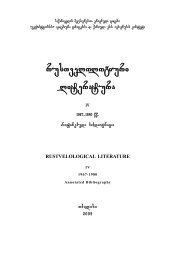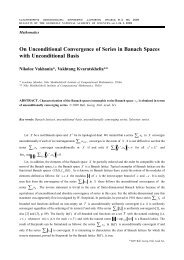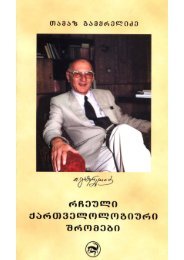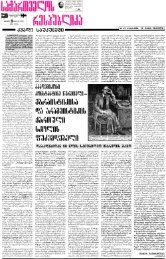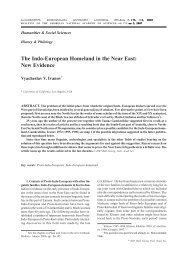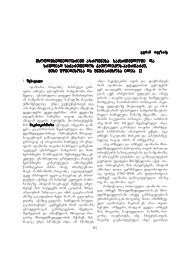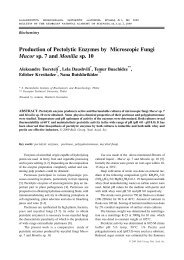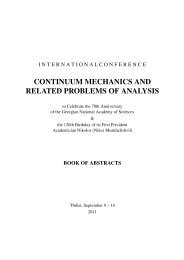Recent Trends in Nostratic Comparative Linguistics - The Georgian ...
Recent Trends in Nostratic Comparative Linguistics - The Georgian ...
Recent Trends in Nostratic Comparative Linguistics - The Georgian ...
Create successful ePaper yourself
Turn your PDF publications into a flip-book with our unique Google optimized e-Paper software.
<strong>Recent</strong> <strong>Trends</strong> <strong>in</strong> <strong>Nostratic</strong> <strong>Comparative</strong> L<strong>in</strong>guistics 157<br />
2. <strong>The</strong> frequency distribution of Proto-<strong>Nostratic</strong> stops (and affricates) <strong>in</strong> the reconstruction proposed by Illič-<br />
Svityč and Dolgopolsky is <strong>in</strong> contradiction to typological predictions, and is, therefore, highly suspect (see<br />
below).<br />
3. Tak<strong>in</strong>g <strong>in</strong>to consideration (1) the radical re<strong>in</strong>terpretation of the Proto-Indo-European consonant system proposed<br />
by Gamkrelidze, Ivanov, and Hopper, as well as (2) the problems <strong>in</strong> the frequency distribution of stops<br />
(and affricates) <strong>in</strong> the reconstruction of the Proto-<strong>Nostratic</strong> phonological system proposed by Illič-Svityč and<br />
Dolgopolsky, a different set of <strong>Nostratic</strong> sound correspondences is warranted.<br />
Each of these assumptions must be evaluated <strong>in</strong>dependently. <strong>The</strong> reasons that each of these assumptions must be<br />
evaluated <strong>in</strong>dependently are as follows: Even if assumption 1 proves to be untenable, it does not <strong>in</strong>validate assumption<br />
2. Likewise, even if assumption 2 proves to be untenable, it does not <strong>in</strong>validate assumption 1. Assumption 3, on<br />
the other hand, is dependent upon assumption 2 but not assumption 1. That is to say, assumption 3 is not dependent<br />
upon any particular reconstruction of the Proto-Indo-European consonant system, though, it goes without say<strong>in</strong>g, if<br />
assumption 1 is valid, it re<strong>in</strong>forces the likelihood that the revised set of <strong>Nostratic</strong> sound correspondences that Bomhard<br />
has proposed is correct. Inasmuch as assumption 3 is dependent on assumption 2, however, if assumption 2 is<br />
<strong>in</strong>valid, then assumption 3 is unnecessary. Moreover, even if assumption 2 is valid and a different set of <strong>Nostratic</strong><br />
sound correspondences is warranted, it does not necessarily follow that the alternative correspondences that Bomhard<br />
has proposed are the only possible scenario, though other scenarios are considerably less likely.<br />
Let us now consider the basis for assumption 2: <strong>The</strong> mistake that Illič-Svityč and Dolgopolsky made was <strong>in</strong><br />
try<strong>in</strong>g to equate the glottalized stops of Proto-Kartvelian and Proto-Afrasian with the traditional pla<strong>in</strong> voiceless<br />
stops of Proto-Indo-European. <strong>The</strong>ir reconstruction would make the glottalized stops the least marked members <strong>in</strong><br />
the Proto-<strong>Nostratic</strong> labial series and the most marked <strong>in</strong> the velar series. Such a reconstruction is thus <strong>in</strong> contradiction<br />
to typological evidence, accord<strong>in</strong>g to which glottalized stops uniformly have the opposite frequency distribution<br />
(most marked <strong>in</strong> the labial series and least marked <strong>in</strong> the velar series). <strong>The</strong> reason that Illič-Svityč’s and Dolgopolsky’s<br />
reconstruction contradicts the typological evidence is as follows: Illič-Svityč and Dolgopolsky posit glottalics for<br />
Proto-<strong>Nostratic</strong> on the basis of a small number of seem<strong>in</strong>gly solid examples <strong>in</strong> which glottalics <strong>in</strong> Proto-Afrasian<br />
and/or Proto-Kartvelian appear to correspond to traditional pla<strong>in</strong> voiceless stops <strong>in</strong> Proto-Indo-European. On the<br />
basis of these examples, they assume that, whenever there is a voiceless stop <strong>in</strong> the Proto-Indo-European examples<br />
they cite, a glottalic is to be reconstructed for Proto-<strong>Nostratic</strong>, even when there are no glottalics <strong>in</strong> the correspond<strong>in</strong>g<br />
Kartvelian and Afrasian forms! This means that the Proto-<strong>Nostratic</strong> glottalics have the same frequency distribution<br />
as the Proto-Indo-European pla<strong>in</strong> voiceless stops. Clearly, this cannot be correct (Alexis Manaster Ramer 1997<br />
makes the same observation). <strong>The</strong> ma<strong>in</strong> consequence of the mistaken comparison of the glottalized stops of Proto-<br />
Kartvelian and Proto-Afrasian with the traditional pla<strong>in</strong> voiceless stops of Proto-Indo-European is that Illič-Svityč<br />
and Dolgopolsky are led to posit forms for Proto-<strong>Nostratic</strong> on the basis of theoretical considerations but for which<br />
there is absolutely no evidence <strong>in</strong> any of the <strong>Nostratic</strong> daughter languages.<br />
<strong>The</strong> question then arises: Do these criticisms completely <strong>in</strong>validate the cognate sets <strong>in</strong>volv<strong>in</strong>g glottalized stops<br />
(and affricates) proposed by Illič-Svityč and Dolgopolsky? Well, no, not exactly – it is not quite that simple. In many<br />
cases, the etymologies are correct, but the Proto-<strong>Nostratic</strong> reconstructions are wrong – here, a simple rewrit<strong>in</strong>g of the<br />
reconstructions is all that is required. Other examples adduced by Illič-Svityč and Dolgopolsky admit alternative<br />
explanations, while still others are questionable from a semantic po<strong>in</strong>t of view and should be abandoned. Once the<br />
questionable examples are removed, there is an extremely small number left over (no more than a handful) that<br />
appear to support their position. However, compared to the massive counter-evidence supplied by Bomhard (2008,<br />
volume 2), even these rema<strong>in</strong><strong>in</strong>g examples become suspect (they may be borrow<strong>in</strong>gs or simply false cognates).<br />
F<strong>in</strong>ally, there are even some examples where the comparison of glottalized stops <strong>in</strong> Proto-Kartvelian and Proto-<br />
Afrasian with pla<strong>in</strong> voiceless stops <strong>in</strong> Proto-Indo-European is correct. This occurs <strong>in</strong> the cases where two glottalics<br />
orig<strong>in</strong>ally appeared <strong>in</strong> a Proto-<strong>Nostratic</strong> root: *C’VC’-. Such roots are preserved without change <strong>in</strong> Proto-Kartvelian<br />
and Proto-Afrasian, while <strong>in</strong> Proto-Indo-European, they have been subject to a rule of regressive deglottalization:<br />
*C’VC’- > *CVC’-.<br />
Bull. Georg. Natl. Acad. Sci., vol. 2, no. 4, 2008





